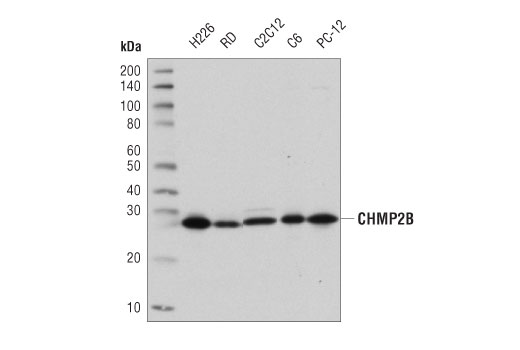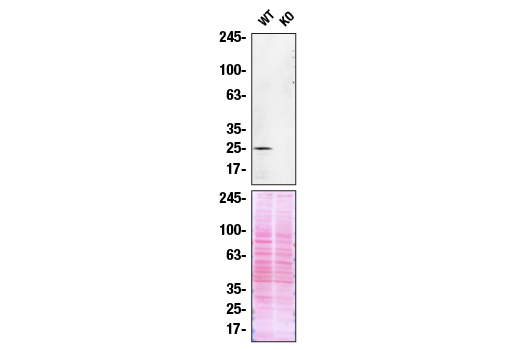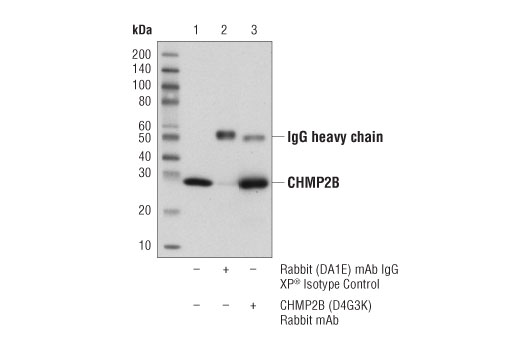WB, IP
H M R
Endogenous
28
Rabbit IgG
#Q9UQN3
25978
Product Information
Product Usage Information
| Application | Dilution |
|---|---|
| Western Blotting | 1:1000 |
| Immunoprecipitation | 1:100 |
Storage
Specificity / Sensitivity
Species Reactivity:
Human, Mouse, Rat
Source / Purification
Monoclonal antibody is produced by immunizing animals with a synthetic peptide corresponding to residues surrounding Glu171 of human CHMP2B protein.
Background
CHMP2B is a component of the ESCRT III (endosomal sorting required for transport complex III) complex (1, 2). The ESCRT system is composed of the ESCRT-0, -I, -II, and -III complexes, which function sequentially to direct the transport of ubiquitinated transmembrane proteins into the intralumenal vesicles (ILVs), which will eventually mature into multivesicular bodies (MVBs). CHMP2B is a homolog of yeast Vps2, which functions in the ESCRT-II complex to change the initial spiral-structure of snf7 into membrane-sculpting helices for the final pinch off process (3). CHMP2B probably functions similarly in mammalian cells. Research studies show that manipulation of the ESCRT-III complex leads to accumulation of CHMP2B at the plasma membrane and overexpressed CHMP2B polymerizes into a tight helical structure that deforms the shape of associated plasma membrane (4).
Research studies have shown that mutation of CHMP2B is associated with frontotemporal dementia, (5, 6). Studies have further shown that the dysfunction of mutant CHMP2B expression may disrupts the normal endo-autophagosome and endo-lysosome pathways and lead to neurodegenerative diseases (6-9).
- McCullough, J. et al. (2013) Annu Rev Biochem 82, 663-92.
- Henne, W.M. et al. (2013) Cold Spring Harb Perspect Biol 5, (9).
- Henne, W.M. et al. (2012) Cell 151, 356-71.
- Bodon, G. et al. (2011) J Biol Chem 286, 40276-86.
- Skibinski, G. et al. (2005) Nat Genet 37, 806-8.
- Lee, J.A. et al. (2007) Curr Biol 17, 1561-7.
- Filimonenko, M. et al. (2007) J Cell Biol 179, 485-500.
- Han, J.H. et al. (2012) Biochem Biophys Res Commun 421, 544-9.
- Urwin, H. et al. (2010) Hum Mol Genet 19, 2228-38.
Species Reactivity
Species reactivity is determined by testing in at least one approved application (e.g., western blot).
Western Blot Buffer
IMPORTANT: For western blots, incubate membrane with diluted primary antibody in 5% w/v BSA, 1X TBS, 0.1% Tween® 20 at 4°C with gentle shaking, overnight.
Applications Key
WB: Western Blotting IP: Immunoprecipitation
Cross-Reactivity Key
H: human M: mouse R: rat Hm: hamster Mk: monkey Vir: virus Mi: mink C: chicken Dm: D. melanogaster X: Xenopus Z: zebrafish B: bovine Dg: dog Pg: pig Sc: S. cerevisiae Ce: C. elegans Hr: horse GP: Guinea Pig Rab: rabbit All: all species expected
Trademarks and Patents
Limited Uses
Except as otherwise expressly agreed in a writing signed by a legally authorized representative of CST, the following terms apply to Products provided by CST, its affiliates or its distributors. Any Customer's terms and conditions that are in addition to, or different from, those contained herein, unless separately accepted in writing by a legally authorized representative of CST, are rejected and are of no force or effect.
Products are labeled with For Research Use Only or a similar labeling statement and have not been approved, cleared, or licensed by the FDA or other regulatory foreign or domestic entity, for any purpose. Customer shall not use any Product for any diagnostic or therapeutic purpose, or otherwise in any manner that conflicts with its labeling statement. Products sold or licensed by CST are provided for Customer as the end-user and solely for research and development uses. Any use of Product for diagnostic, prophylactic or therapeutic purposes, or any purchase of Product for resale (alone or as a component) or other commercial purpose, requires a separate license from CST. Customer shall (a) not sell, license, loan, donate or otherwise transfer or make available any Product to any third party, whether alone or in combination with other materials, or use the Products to manufacture any commercial products, (b) not copy, modify, reverse engineer, decompile, disassemble or otherwise attempt to discover the underlying structure or technology of the Products, or use the Products for the purpose of developing any products or services that would compete with CST products or services, (c) not alter or remove from the Products any trademarks, trade names, logos, patent or copyright notices or markings, (d) use the Products solely in accordance with CST Product Terms of Sale and any applicable documentation, and (e) comply with any license, terms of service or similar agreement with respect to any third party products or services used by Customer in connection with the Products.


